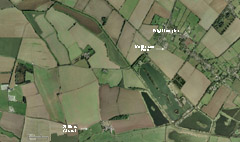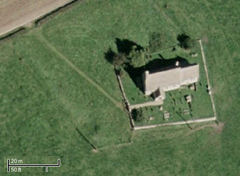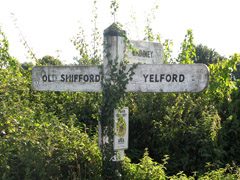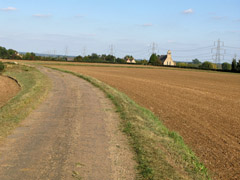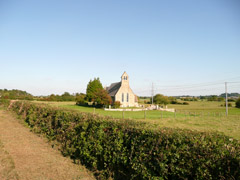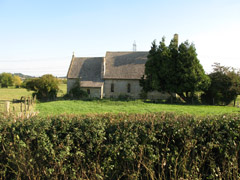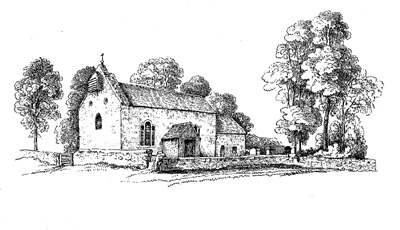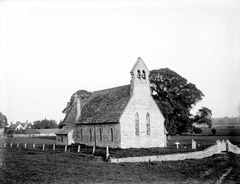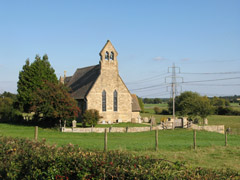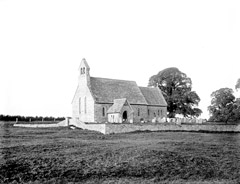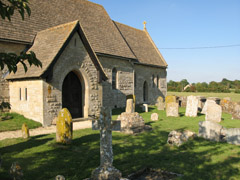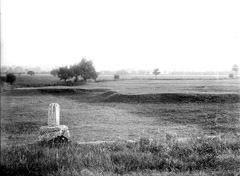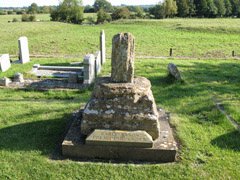

Return to Other Settler Familes List
Brown Family Page Pre-emigration generation A, 1, 2, 3, 4, 5, 6, 7, 8, 9, 10, 11,
12, 13, 14, 15, 16, 17, 18, 19, 20, 21, 22, 23, 24, 25, 26, 27, 28, 29, 30, 31, 32, 33, 34,
35, 36, 37, 38, 39, 40, 41, 42, 43, 44, 45, 46, 47, 48, 49, 50, 51, 52, 53, 54, Index
Return to Thomas Brown and Sophia Hissey Family Entry
Images of St. Mary's Parish Church, Shifford and it's predecessor Shifford Chapel
*********************************************************************************************Thomas Brown and Sophia Hissey had at least 11 children, most of whom were christened at Shifford Chapel (Goadby, 1970). The Brown family seems to have had an association with this building reaching back several generations. The building was razed in 1861 due to ongoing structural problems, which stemmed largely from a damaging flood in 1772 when the River Thames changed its course and part of the structure fell into the river. The successor church, St. Mary's was immediately built in 1861-1862.
The Shifford Parish records survive from 1783 with older records being destroyed by damp caused most likely by the 1772 flood. Incomplete records are available to 1721, which are from the Bishop's Transcripts held at the Wilshire Record Office, Trowbridge (Goadby, 1970). This record is available from the Oxfordshire Family History Society as a microfiche or also available here as a very large downloadable pdf file (231 MB).
A history of the Shifford Church compiled for British History Online is reprinted at the bottom of this page as an appendix.
Medium sized pop up image
900 X 532, 72 dpi, 181 kFull sized pop up image
1314 X 776, 72 dpi, 739 kAir photo showing relative position of Malthouse Farm and the Shifford Church (see images below) where all of the children of Thomas Brown and Sophia Hissey were christened as well as the burial place of several generationsof the Brown family. Source: Google Maps.
Medium sized pop up image
700 X 380, 72 dpi, 258 kFull sized pop up image
1377 X 747, 72 dpi, 698 kMedium sized pop up image
517 X 379, 72 dpi, 152 k
Left: Aerial view of St. Mary's Church, Old Shifford (small structure to left). Right: Close-up aerial view of St. Mary's Church, Old Shifford. Source of both photographs, Google Maps October 2007.
Medium sized pop up image
700 X 525, 72 dpi, 227 kFull sized pop up image (4X6 crop for printing)
3648 X 2736, 180 dpi, 5156 kMedium sized pop up image
700 X 525, 72 dpi, 163 kFull sized pop up image (4X6 crop for printing)
3648 X 2736, 180 dpi, 5339 k
Left: Wooden signpost on the turnoff to Old Shifford From Cote / Aston Road. Right: View south along road to the extinct village of Old Shifford with St. Mary's Parish Church in Old Shifford in distance. Source of both photographs, Tim Patterson, 4 Sep 2007.
Medium sized pop up image
700 X 525, 72 dpi, 166 kFull sized pop up image (4X6 crop for printing)
3072 X 2304, 180 dpi, 4654 kMedium sized pop up image
700 X 525, 72 dpi, 199 kFull sized pop up image (4X6 crop for printing)
3072 X 2304, 180 dpi, 7088 k
Left: View of St. Mary's Parish Church, Old Shifford from west. Built in 1861-1862 to replace a previous structurally unsound chapel illustrated below. Source: Helen Roe, 4 Sep 2007. Right: View of St. Mary's Parish Church, Old Shifford from north. Source: Tim Patterson, 4 Sep 2007.
Medium sized pop up image
900 X 517, 72 dpi, 281 k
Sketch of Shifford Chapel, circa 1850. A chapel has existed on this site since ca AD 1230. The chapel was periodically modified although the position of the church on the flood plain of the Thames contributed to the deterioration of the structure. This difficulty was noted in the early 18th century when it was stipulated that prayers and a sermon would occur at Shifford 'when the weather and floods permit'. By the late 18th century the structure was periodically left derelict. By 1787 repairs had been made and by the early 19th century ~30 persons attended services regularly, a number which increased to ~50 by 1851. This was the state of affairs when Thomas Brown and Sophia Hissey attended services here with their children, all of whom were christened here. The building was in need of almost constant repair though so it was decided in 1861 that it would be best to raze the structure and rebuild on the same foundation. The current St. Mary's Church illustrated below was immediately built in 1861-1862 and still is in occassional use. Source: History of the County of Oxford, vol 13. For more detailed information see: http://www.british-history.ac.uk/report.aspx?compid=15957
Medium sized pop up image
700 X 537, 72 dpi, 183 k
Medium sized pop up image
700 X 525, 72 dpi, 162 kFull sized pop up image (4X6 crop for printing)
3648 X 2736, 180 dpi, 4649 k
Medium sized pop up image
700 X 553, 72 dpi, 232 k
Medium sized pop up image
700 X 556, 72 dpi, 185 kFull sized pop up image (4X6 crop for printing)
3648 X 2736, 180 dpi, 7524 k
Medium sized pop up image
700 X 514, 72 dpi, 195 k
Medium sized pop up image
700 X 556, 72 dpi, 185 kFull sized pop up image (4X6 crop for printing)
3648 X 2736, 180 dpi, 7524 k
Left: AD 1887 south looking view of Court Close from the church yard of St Mary's Church, Shifford, Oxfordshire. There was a local tradition, current by 1677, that King Alfred held a witan at Shifford. This legend arose from a reference to 'Sifford' or 'Sevorde' in the probably 12th- century poem known as 'The Proverbs of Alfred'. The probability that the poem referred to an actual assembly is unlikely, and the identification with Shifford is impossible on linguistic and historical grounds as Oxford and the region dependent on it were not directly controlled by Wessex until 911. Significant assemblies would have presumably met at Bampton in any event. The names Court close (for the area around the chapel) and Kingsway field, cited in support of the tradition in the 19th century, refer respectively to the site of Eynsham abbey's manorial farmstead, and to a lane leading through Aston apparently to the royal tûn at Bampton. In the foreground is the base of what is reputed to be a Saxon era preaching cross originating from an early iteration of the chapel. Source: Photographer Henry W. Taunt (1887). Reference no: HT05196 Archive Holder: Centre for Oxfordshire Studies. Right: Similar view of Court Close and the Saxon preaching cross taken in 2007. Source: Tim Patterson, 4 Sep 2007.
Left: Another view of earthworks in the field known as Court Close toward the southwest from St. Mary's Churchyard as described in the caption above. Source: Photographer Henry W. Taunt (1887). Reference no: HT05195 Archive Holder: Centre for Oxfordshire Studies.
Medium sized pop up image
700 X 553, 72 dpi, 232 kFull sized pop up image
3600 X 2400, 600 dpi, 3237 k
Medium sized pop up image
700 X 553, 72 dpi, 232 kFull sized pop up image (4X6 crop for printing)
3600 X 2400, 600 dpi, 3237 kMedium sized pop up image
700 X 556, 72 dpi, 126 kFull sized pop up image (4X6 crop for printing)
3600 X 2400, 600 dpi, 3237 k
References
Baggs, A.P., Chance, E., Colvin, C., Day, C.J., Selwyn, N., Townley, SC, 1996. 'Shifford: Church', A History of the County of Oxford: Volume 13: Bampton Hundred (Part One) pp. 108-110. In Crossley, A., Currie, CRJ (eds). A History of the County of Oxford: Volume 13.
URL: http://www.british-history.ac.uk/report.aspx?compid=15957.
Goadby, F.R.L. 1970. Shifford Parish Registers (1721-1969). Oxfordshire Family History Society. 71 p. (available from the Oxfordshire Family History Society as a microfiche). Available here as downloadable pdf file (very large file at 231 MB)
Supplemental Information:
A history of the Shifford Church compiled for British History Online by Baggs et al. (1996) is reprinted below:
A chapel existed c. 1230 when Eynsham abbey, as lord, agreed to give the vicars of Bampton 2 lb. of wax a year for lighting it on St. Laurence's feast day. (fn. 19) It had no endowment and remained subject to Bampton until 1857, when under Order in Council of 1845 it was incorporated into Bampton Aston parish, (fn. 20) from 1976 part of the united benefice of Bampton with Clanfield. (fn. 21) The chapelry in 1405 and still in the 19th century included Shifford, Cote, Chimney, and that part of Brighthampton within Bampton parish. (fn. 22) In the late 15th century inhabitants of Shifford and Chimney successfully petitioned the dean of Exeter to allow burial at Shifford, though in the 16th and 17th centuries testators sometimes specified burial at the mother church. (fn. 23) The chapel had baptismal rights by the 18th century and probably from the Middle Ages. (fn. 24).
In the early 15th century the chapel was served by a chaplain from Bampton once a week. (fn. 25) Then and throughout the 14th century the abbot of Eynsham was obliged to accommodate him in the manor house on the nights of Christmas, Easter, and St. Laurence's day, providing ale, light, and oats, and supplying 2 candles at vespers on the vigil of St. Laurence. (fn. 26) In 1499 the abbey allowed a cottage in Cote to be used by the chapelwardens for church ales, though in 1504 and 1506 it was in disrepair. (fn. 27) In 1510 the homage of Shifford agreed that no-one should fish with cooppis for nine months except for the benefit of Shifford chapel, (fn. 28) and several 16th and 17th-century testators made bequests towards the chapel's upkeep, (fn. 29) among them members of the Veysey family of Chimney, some of whom were buried there. (fn. 30)
Few medieval chaplains are known, (fn. 31) though 16th-century curates and clerks witnessing Shifford or Chimney wills may have served the chapel. (fn. 32) Edward Joye (curate c. 1634), a graduate of St. John's College, Cambridge, and probably related to the Bampton vicar Robert Joye (d. 1614), was a schoolmaster in Bampton, (fn. 33) and William Standard, an intruded vicar of Bampton probably ejected c. 1662, may have been curate in 1664. (fn. 34) In the late 17th century and early 18th Thomas Horde (d. 1715) of Cote worshipped and received the sacrament regularly at Shifford; (fn. 35) by then the weekly duty, one morning service with prayers and a sermon 'when the weather and floods permit', (fn. 36) was evidently undertaken by vicars of Bampton or their substitutes, who arranged for replacements from Oxford as necessary. From the 1730s the cure was served without licence for £20 a year by Thomas Middleton, the non-resident vicar of Clanfield, who by 1738 employed his Clanfield curate to do the duty every third Sunday and was criticized by the bishop for consequent disruption of services in his own parish. In 1750 the Bampton vicar William Reynolds substituted his own resident curate, citing local demands for an additional Sunday service and alleging that Middleton's farming activities and numerous benefices prevented him from fulfilling his duties adequately; thereafter Middleton served Shifford only occasionally, but was still claiming arrears against Reynolds' widow in 1752. (fn. 37)
From c. 1772 to 1784 the chapel was derelict and there were no services, and following its reopening the chancel remained for some years in such disrepair that the sacrament could not be administered, parishioners and the chief landowners being unwilling to meet the cost of renovation. (fn. 38) By 1787 repairs were complete, but there continued to be only one Sunday service and sermon, with the sacrament administered three times a year to 18-20 communicants in 1790, and by 1808 four times a year to 20 or 30. Average attendance in 1851 was 50 for the weekly service. During the earlier 19th century the chapel continued to be served in rota by the vicars or their curates and occasionally by outsiders; (fn. 39) it briefly had its own curate c. 1863, but from 1857 was served usually by the curate and later by the vicar of Aston, who conducted a morning or afternoon service with a sermon to fit in with his Aston duty. (fn. 40) In 1896 there were 2 services a month but in the 1960s only one, and in 1991 there were monthly evening prayers and a monthly communion. (fn. 41)
The chapel of ST. MARY, so called by 1891 (fn. 42) but dedicated in the Middle Ages to St. Laurence, (fn. 43) is of 1861-2. Nothing remains of its medieval predecessor except a rehung, possibly 13th-century bell, and the base of an apparently medieval cross in the churchyard. (fn. 44) Window glass needed repair in 1510, and in the early 18th century a south window contained figures reportedly of the Virgin, St. James, and St. Anthony; (fn. 45) a testator in 1605 requested burial in the south aisle near his seat, and made bequests towards building two pillars or buttresses against the chapel's north wall. (fn. 46) The chancel of the 'ancient', presumably medieval, building was in disrepair in 1770, and by 1772 the 'greatest part' of the chapel was ruinous, the rest being 'in a very bad condition and not fit to, stand'. Rebuilding began c. 1781 and the chapel was serviceable by 1784, though the chancel remained 'much dilapidated by the long ruin of the church' until c. 1787, confirming that the chapel was rebuilt on the same site probably incorporating parts of the medieval fabric. (fn. 47) In the early 19th century it was of stone and slate and comprised a gabled, evidently aisleless nave with a plain south porch, and a lower, gabled chancel with a round-headed south door and a large, pointed east window, possibly of 14th- century origin. In the west gable of the nave were two small circular openings with, below, a central, possibly round-headed window. All other fenestration was modern, including two Venetian windows in the nave south wall flanking the central porch. (fn. 48) The chancel arch, said in the later 19th century to have been 'Saxon', (fn. 49) was presumably rounded. There was a gallery by the mid 19th century, when the chapel, said to be 'hardly distinguishable from the cottages', had 109 sittings, only 31 of them free. (fn. 50)
In 1861 it was decided to rebuild rather than repair the chapel, the cost being met by mortgage, subscriptions, and other donations, and work was completed early in 1862. (fn. 51) The building, (fn. 52) designed in Gothic style by Joseph Clarke and built on its predecessor's foundations, (fn. 53) is of stone with Stonesfield-slated roofs, and comprises a small chancel with a vestry on the north, and a nave with south porch and west bellcote; it is lit by plain lancets and by a small quadripartite circular east window. New glass with coloured medallions, and stained glass in the circular east window, was inserted in 1971. (fn. 54) The larger bell, similar to products of the Burford foundry, is of 1685 and is inscribed 'H. Allen', probably a chapelwarden; (fn. 55) the font and pulpit are modern. Electric heating replaced a coke stove in 1964, but lighting was partly from candles until 1976. (fn. 56)
Reset against the inside west wall of the nave are a grave slab to Thomas Brown (d. 1799) and his wife Mary, and a black slate tablet to Susan Blithe (d. 1645), related by marriage to the Veyseys of Chimney. (fn. 57) Several 18th-century monuments survive in the churchyard, among them a large tomb-chest to Robert Darby (d. 1772) of Cote and his wife Mary (d. 1801). (fn. 58) The plate includes a silver chalice given by Robert Veysey (d. 1666) and repaired by his relict Christian in 1688-9, and a silver paten given in 1706 by Thomas Horde (d. 1715)53 silver chalice and paten of 1855 were given by the widow of W. M. Birch, vicar of Bampton Aston 1900-12. (fn. 59) Registers survive from 1783, earlier ones having apparently been irreparably damaged while the chapel was derelict. (fn. 60) The churchyard was closed for burials c. 1969. (fn. 61).
Footnotes:
19 D. & C. Exeter, MS. 3672, p. 8; for dedication to St. Laurence, below.
20 D. & C. Exeter, MSS. 648, 2865; Ch. and Chapel, 1851, no. 381; Lond. Gaz. 30 Dec. 1845, p. 7354.
21 O.R.O., MS. Oxf. Dioc. c 1713/2, Order in Council 12 Apr. 1976.
22 D. & C. Exeter, MS. 648; O.R.O., MS. Oxf. Dioc. d 571, f. 75; ibid. MS. Oxf. Archd. Oxon. b 26, f. 270.
23 Oxoniensia, lvi. 112-13; O.R.O., MSS. Wills Oxon. 180, ff. 114v.-115; 184, ff. 16v., 21 and v., 116v.; 185, ff. 201v.-202, 460; 3/2/55, 3/3/28, 5/5/1, 22/1/13, 25/1/29, 43/1/20, 126/1/2; P.R.O., PROB 11/288, ff. 242v.-243; C.O.S., par. reg. transcripts.
24 C.O.S., par. reg. transcripts; for marriages, O.R.O., MS. Oxf. Dioc. c 658, f. 167.
25 B.L. Harl. Roll L. 3; s.v. expense forinsece.
26 Eynsham Cart. ii, p. 6; Bodl. MS. d.d. Harcourt c 128/1; B.L. Harl. Rolls L. 3-4.
27 Eynsham Cart. ii, p. lxvii; Bodl. MS. d.d. Harcourt c 127/3, ct. 5 Oct. 20 Hen. VII; ibid. c 127/4.
28 Eynsham Cart. ii, p. lxvii.
29 e.g. O.R.O., MSS. Wills Oxon. 11/1/32, 25/1/68, 39/1/63, 43/4/47, 127/1/6; ibid. 184, f. 16v.; P.R.O., PROB 11/132, f. 242 and v.; PROB 11/107, ff. 282-3.
30 O.R.O., MS. Wills Oxon. 68/3/23; P.R.O., PROB 11/169, f. 59; PROB 11/252, f. 293.
31 For a possible example, J. Blair, 'Medieval Clergy' (Bampton Research Paper 4, priv. print. 1991), app. C, col. 17: copy in C.O.S.
32 Geof. Slyngar (c. 1556-9), Rob. Duccurth (1552), John Burnet (c. 1597-1602): O.R.O., MSS. Wills Oxon. 180, ff. 108v.-109; 184, f. 116v.; 186, f. 73 and v.; ibid. 11/1/32; 11/1/70; 39/1/63; O.A.S. Rep. (1913), 157; ibid. (1914), 189, 201; C.O.S., Standlake par. reg. transcripts, s.a. 1600.
33 O.R.O., MS. Oxf. Dioc. e 9, ff. 182-3; ibid. MSS. Wills Oxon. 68/3/23, 131/5/29; Bodl. MS. Top. Oxon. c 118, f. 9; C.O.S., Bampton par. reg. transcripts, s.a. 1614.
34 Der Pietismus in Gestalten and Wirkungen, ed. H. Bornkamm et al. (Arbeiten zur Geschichte des Pietismus, xiv), 349; O.R.O., MS. Oxf. Archd. Oxon. c 131, f. 18; cf. ibid. Cal. Oxf. presentation deeds, ser. 1.
35 Par. Colln. iii. 253-4.
36 O.R.O., MS. Oxf. Dioc. b 15, f. 98; cf. ibid. d 558, f. 35; Secker's Visit. 13.
37 Secker's Corresp. 9, 191-4, 216-17.
38 O.R.O., MS. Oxf. Archd. Oxon. c 99, ff. 27-42; ibid. MSS. Oxf. Dioc. d 564, ff. 29-31; c 327, p. 134; below, this section.
39 O.R.O., MSS. Oxf. Dioc. d 571, ff. 75-6; d 705, f. 22; b 38, ff. 15-16; ibid. MS. Oxf. Archd. Oxon. b 26, f. 272; Ch. and Chapel, 1851, no. 381, misleadingly implying two services: cf. Wilb. Visit. 12.
40 Wilb. Letter Bks., p. 395; O.R.O., MSS. Oxf. Dioc. c 332, p. 58; c 335, f. 27v.; c 338, f. 33v.; c 341, f. 46v.; c 353, f. 31.
41 O.R.O., MSS. Oxf. Dioc. c 362, ff. 31-2; c 1710, corresp. re faculty 1964; notice in ch. 1991.
42 Census, 1891; Oxf. Dioc. Yr. Bk. (1990), 87; cf. Bodl. MS. Dep. d 78, f. 66, claiming dedication 'to the mother of St. Paul', presumably in error.
43 D. & C. Exeter, MS. 3672, p. 8; Cal. Papal Reg. i. 544, referring probably to St. Laurence martyr rather than St. Laurence abp.: cf. Oxf. Dict. of Saints (2nd edn.), s.v. St. Laurence.
44 Ch. Bells Oxon. iv, p. 370; Oxoniensia, xxxviii. 308; cf. Par. Colln. iii. 368.
45 Eynsham Cart. ii, p. lxvii; Par. Colln. iii. 254-5.
46 P.R.O., PROB 11/107, ff. 282-3.
47 O.R.O., MS. Oxf. Archd. Oxon. c 99, ff. 26-42; ibid. MS. Oxf. Dioc. c 327, p. 134; Giles, Hist. Bampton, 86 n.; Bodl. MS. Dep. d 78, f. 66; cf. Jefferys, Oxon. Map (1767).
48 B.L. Add. MS. 36356, f. 156b, showing the roof of a N. aisle apparently in error; Bodl. MS. Top. Oxon. b 90, no. 82; O.R.O., MS. Oxf. Archd. Oxon. c 42, ff. 235v., 239v.-240; Giles, Hist. Bampton, facing p. 84. Bodl. MS. Top. Oxon. a 68, no. 457, labelled Shifford, depicts a different ch.
49 Bodl. MS. Top. Oxon. d 218, f. 211v.
50 Ibid. c 104, ff. 274-5; ibid. MS. Dep. d 78, f. 66.
51 Oxf. Chron. 9 Feb., 29 June, 6 July 1861; Bodl. MSS. Top. Oxon. c 104, ff. 274-80; c 103, ff. 42-3; O.R.O., MSS. Oxf. Dioc. d 795, ff. 142v.-143; d 796, f. 43.
52 Bodl. MS. Top. Oxon. c 852, f. 74, mislabelled 'Yelford'; ibid. c 522, f. 22; Pevsner, Oxon. 754, which misdates it.
53 Ch. Com. Rec. L 7, p. 439.
54 O.R.O., MS. Oxf. Dioc. c 1710, faculty 1971.
55 Ch. Bells Oxon. iv, p. 371.
56 O.R.O., MS. Oxf. Dioc. c 1710, faculty 1964; local inf.
57 Cf. Par. Colln. iii. 254-5; Bodl. MS. d.d. Harcourt c 109/29.
58 For inscriptions, Giles, Hist. Bampton, 174-5.
59 Evans, Ch. Plate Oxon. 11-12.
60 O.R.O., MSS. d.d. Par. Shifford, e 1-3, b 1; ibid. MS. Oxf. Dioc. c 658, ff. 167-8; cf. ibid. c 596, containing some transcripts from 1721.
61 Local inf.
